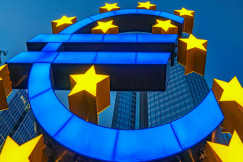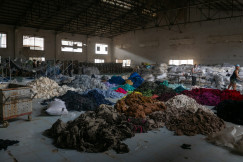Library
07 July 2025
The EU’s 2024 Industrial Report reveals green and digital pathways for textiles transformation
Library
07 July 2025
Ecosystem's readiness to support EU strategic autonomy and defence efforts
Infrastructure
Investments and funding
+17 more
Login / create an account to be able to react
-
18

The EU’s 2024 industrial report highlights steady progress in making the textiles sector greener and more digital. While energy saving measures and recycling startups are on the rise, climate neutrality and advanced digital adoption remain limited. Greater investment and skills development are key to accelerating this transition.
Topics
Albania
Armenia
Austria
Belgium
Bosnia and Herzegovina
Bulgaria
Croatia
Cyprus
Czechia
Denmark
Estonia
EU-27
Finland
France
Georgia
Germany
Greece
Hungary
Iceland
Ireland
Italy
Kosovo
Latvia
Liechtenstein
Lithuania
Luxembourg
Malta
Moldova
Montenegro
Netherlands
North Macedonia
Norway
Poland
Portugal
Romania
Serbia
Slovakia
Slovenia
Spain
Sweden
Switzerland
Türkiye
Ukraine
Other
Academic / Research and VET Institutions
Business Support Organisation
Company with 250 or more employees
Cluster Organisations
Consumer Organisations
Cultural and Heritage Organisations
Destination Management & Marketing Organisations
EU Institutions
Financial Institutions and Investors
Industry Associations and Chambers of Commerce
International Organisations
Local Authorities
Media / Journalist Organisations
National authorities
Networks and Federations / Confederations
NGOs / Non-profits
Notified Bodies
Regional Authorities
SMEs (a company with less than 250 employees)
Social Economy Entity
Trade Unions
Other
-
Transition Pathway's building blocks
-
-
Ecosystem's readiness to support EU strategic autonomy and defence efforts
-
Infrastructure
-
Investments and funding
-
R&I, techniques and technological solutions
-
Skills
-
Social dimension
-
Sustainable competitiveness
-
Regulation and public governance
-
-
Industrial ecosystems
-
-
Textile
-
-
Textiles ecosystem areas
-
-
Fibres, yarns and fabrics
-
Apparel and clothing accessories
-
Household/interior textiles
-
Technical textiles
-
Leather and fur
-
Footwear
-
Research and Innovation
-
Technology and Machinery
-
Waste management, reuse and repair
-
Business support and Communication
-
Not area specific (interested in more than one of the above)
-
Share
The European Commission’s latest analytical report on the textiles industrial ecosystem highlights the progress and challenges of the sector’s green and digital transitions. The 2024 edition, prepared under the European Monitor of Industrial Ecosystems (EMI) project, assesses efforts by businesses, public institutions and startups to drive sustainability and innovation across the textiles value chain.
The report identifies clear yet uneven advancements in environmental practices. While energy saving technologies and waste reduction measures are widely adopted, broader climate neutral strategies and circular economy models remain limited. Digital innovation is expanding, particularly through smart textiles and cloud computing, but advanced technology uptake still lags global competitors.
Key takeaways
Green Transition
- 65% of textile companies implemented waste reduction; 58% improved energy savings in 2024.
- Recycling startups have grown, but only 18% of businesses adopted climate-neutral strategies.
- Horizon Europe has significantly boosted funding for green projects: 73% of textiles related EU R&I funds support the green transition.
- Skills gaps remain stark: only 2.9% of LinkedIn-registered professionals in textiles held green skills in 2024.
Digital Transition
- Innovations in robotics, AI, and smart textiles are increasing, yet the adoption of digital transformation strategies remains limited.
- 26% of companies reported having a digital strategy in 2024; 25% adopted AI solutions.
- Only 4% of professionals in textiles held advanced digital skills; most companies still invest less than 1% of their revenue in AI.
Environmental Impact
- The sector’s material use for production is falling, but overall consumption based material use continues to rise.
- Land use and water consumption have stabilised, showing modest progress on sustainability targets.
The report underscores the importance of targeted investments, regulatory support, and skills development to ensure that the textiles industry meets its sustainability and competitiveness goals.
Read the full 2024 textiles ecosystem report by the European Commission here.
Comments (0)
See also
-
33
Small mid‑caps: bridging the gap between SMEs and large companies
- Categories
- Infrastructure Investments and funding R&I, techniques and technological solutions +28 more
-
51
Transition Pathway for a resilient, sustainable, and digital textiles ecosystem
- Categories
- Infrastructure Investments and funding R&I, techniques and technological solutions +28 more
-
118
The EU’s vision for sustainable fashion: transforming the textiles sector by 2030
- Categories
- Infrastructure Investments and funding R&I, techniques and technological solutions +28 more




